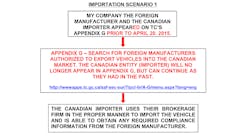Something strange is happening in the Class 8 truck market. We just had record quarterly orders in Q4, making 2014 the second-highest order year ever. This order deluge has pumped up backlog to the highest point since 2006.
So you would expect production in 2015 to get off to a rip-roaring start, with factories going full-out to churn out loads of trucks to satisfy this torrid demand. However, this did not happen. January production was much below expectation, 18% lower than last November, on a per day basis. Factories were easily able to satisfy order requirements without working much, if any, overtime.
What is going on here? It’s not enough to just look at the order and backlog numbers by themselves—it is also important to analyze the delivery dates on the orders and the quarterly distribution of the total backlog.
I had previously posted about the unusually large number of orders placed in 2014Q4 for second-half 2015 delivery. However, what was not obvious at the time was that not enough of those orders were being placed for 2015Q1 delivery to put significant pressure on OEM build rates in the short-term. In other words: many orders for delivery in seven months, fewer orders for delivery in three months.
Yes, order patterns had changed in two important ways, both related to the Great Recession. First, some of the Q4 orders can be considered “catch-up” orders. They should have been placed up to a year earlier but were not, due to residual caution and risk aversion from the Great Recession. It is the pent-up demand from fleets needing new equipment, for both replacement and expansion, but not placing orders because of leftover economic anxiety. By using a new data analysis method, FTR was able to determine that the backlog of six months ago was inadequate to support the expected sales. Therefore, orders needed to increase to support the market environment. We got them, but a few months later than normal.
The second factor is that the Great Recession caused OEMs to reduce industry capacity. Several plants were closed, resulting in capacity falling from 375,000 units/year to 350,000 (new calculation based on November 2014 production rates). Because of very tight production capacity in Q4, fleets were motivated to place large orders to reserve production slots in Q3 and Q4, 2015.
Truck OEMs are resistant to investing in new fixed capacity because of the cost and the cyclical nature of the business. These types of decisions are being made throughout the industry. One component supplier that closed three plants during the Great Recession opened a brand-new facility last year.
At this point, it looks like the extra-heavy Q4 was the result of OEM sales strategies to try to gain or lock-up market share this year. It does not appear the huge orders signaled record sales, and production capacity should not be maxed in 2015. Of course if the economy and freight grow faster than forecasted this year, increasing truck demand could indeed maximize production.
Things are different on the trailer side. The orders have been huge, but most of the major OEMs are running at full capacity and expect to stay that way through at least Q3.
About the Author: Don Ake
Don has more than 20 years of experience in the transportation industry, including 16 years with industry supplier Hendrickson International. Don has a strong forecasting and market analysis background. While at Hendrickson, Don developed forecasting models, methods and processes to accurately forecast truck and trailer builds and product demand.


